
They didn’t have essential oil diffusers or fancy supplement gummies, but moms in the 1950s had their own kind of wisdom. It came in tin salves, kitchen pantry brews, and steaming bowls of something pungent. These women knew how to soothe a cough, heal a bruise, or ease a sleepless night with things you’d find in any well-stocked home. Their remedies weren’t flashy, but they worked, and now, decades later, science is finally catching up.
From castor oil to mustard plasters, many of the remedies passed down from our mothers and grandmothers are now being re-evaluated in labs and medical journals. Some were pure folk wisdom. Others? Surprisingly ahead of their time. Whether you’re feeling run-down or just nostalgic for a simpler care, these 15 old-school cures might become your modern-day medicine cabinet staples.
1. Gargling Salt Water for a Sore Throat

Long before throat sprays and lozenges took over medicine cabinets, the go-to remedy for a sore throat was a simple glass of warm salt water. Moms in the 1950s swore by this pantry fix, often recommending a ratio of half a teaspoon of table salt to eight ounces of warm water. The solution wasn’t just soothing it was strategic. Salt is naturally antimicrobial, and when dissolved in water, it creates a hypertonic solution that draws fluids out of inflamed throat tissue, flushing out bacteria, viruses, and allergens in the process. The warmth of the water helps loosen mucus and relax tight throat muscles, while the salt reduces swelling. This method was particularly common in public school nurses’ offices, where budget-friendly treatments were preferred. Even soldiers during World War II were taught to gargle salt water in the field to ward off illness and maintain vocal health during winter campaigns.
Decades later, the science holds. A randomized controlled trial conducted in 2013 by researchers in Japan found that participants who gargled three times a day with salt water were 40% less likely to develop upper respiratory infections than those who didn’t. In clinical microbiology, saline rinses are also shown to reduce viral load in the throat, which may help limit the severity of infections like colds, influenza, or even coronaviruses. It’s a remedy that transcends generations, used by singers, teachers, and athletes to maintain vocal cord and throat health. It’s also still recommended today by organizations like the Mayo Clinic and CDC as a first-line, low-risk treatment for sore throats. In terms of accessibility, it remains one of the cheapest, fastest, and most effective tools you can use at home no prescription required. Source: Mayo Clinic
2. Using Baking Soda for Heartburn

In the 1950s, before antacids lined pharmacy shelves, a spoonful of baking soda mixed into a glass of water was one of the most common remedies for heartburn. Housewives kept Arm & Hammer in the pantry not just for cleaning but as a reliable standby for digestive troubles. Baking soda, or sodium bicarbonate, is a natural alkaline compound that neutralizes excess stomach acid almost instantly. When combined with water and swallowed, it reacts with hydrochloric acid in the stomach to form salt, water, and carbon dioxide gas often resulting in a satisfying burp. The relief comes within minutes, making it a go-to after heavy meals, especially when indigestion followed rich casseroles, gravy-laden dinners, or mid-century desserts like gelatin molds and pineapple upside-down cake. The remedy was so trusted it was printed on baking soda boxes and endorsed in household manuals. Doctors even used it post-surgery to reduce gastric discomfort before modern acid blockers existed.
Today, sodium bicarbonate is still recognized by the FDA as a safe and effective antacid, though with some caveats. It’s frequently used in emergency rooms as a fast-acting treatment for severe acid overload, and it’s included in many over-the-counter antacids in buffered form. However, experts warn it shouldn’t be overused due to its high sodium content, which can affect blood pressure or cause alkalosis if taken too frequently. Still, when used occasionally and correctly about half a teaspoon in four ounces of water it offers one of the fastest-acting acid relief options available without a prescription. Some studies have explored its potential in reducing exercise-induced lactic acid buildup and even as a kidney health support tool. While newer medications like H2 blockers and PPIs now dominate, baking soda remains one of the most chemically sound and immediate ways to reduce acid in the digestive tract. Source: Medical News Today
3. Rubbing Vicks VapoRub on the Chest (and Feet)
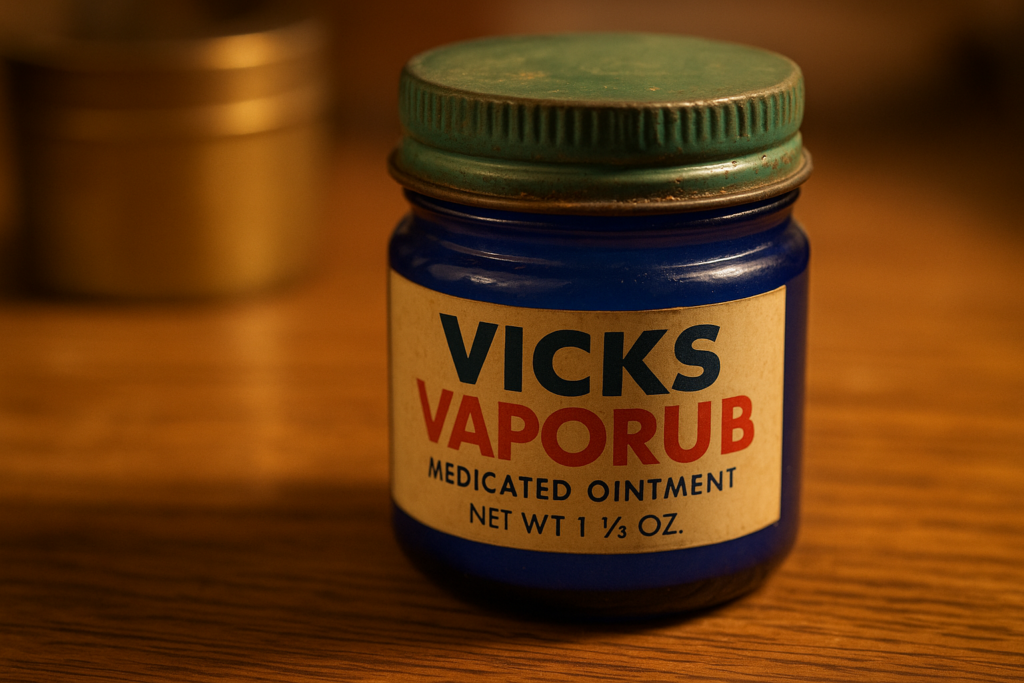
Vicks VapoRub was practically a household deity in the 1950s. The little blue jar came out if a kid so much as sniffled. Mothers would rub the mentholated ointment thick across their children’s chests, necks, and sometimes even the soles of their feet, then cover them with socks to “seal in the medicine.” The idea wasn’t magic, it was menthol. Vicks contains menthol, camphor, and eucalyptus oil, all of which trigger cold receptors in the skin and nasal passages, creating the sensation of easier breathing. While it doesn’t decongest airways directly, this cooling illusion helps calm the body’s response to congestion. The ritual often included a warm washcloth over the chest or being tucked under extra blankets to “sweat out” the cold. The brand’s widespread use began in the early 20th century but reached peak cultural presence post-WWII, when advertising emphasized family care and wartime trust in pharmaceutical science.
Today, VapoRub is still sold in over 60 countries and continues to be used by parents and adults alike. A study published in Pediatrics 2010 found that children with nighttime cough and congestion slept significantly better after being treated with VapoRub than those given a placebo or nothing. Though doctors caution against using it on infants or broken skin due to risks from camphor absorption it’s largely safe for children over two and adults when applied externally. The practice of applying it to feet has no scientific proof but persists, possibly due to the calming scent aiding sleep rather than affecting symptoms directly. Interestingly, Vicks has also been studied for minor fungal infections and has shown promise against toenail fungus, thanks to its thymol and eucalyptus content. While not a cure-all, the combination of sensory comfort and slight antimicrobial action means this old-school remedy still earns its place in medicine cabinets today. Source: National Library of Medicine
4. Honey and Lemon for Coughs
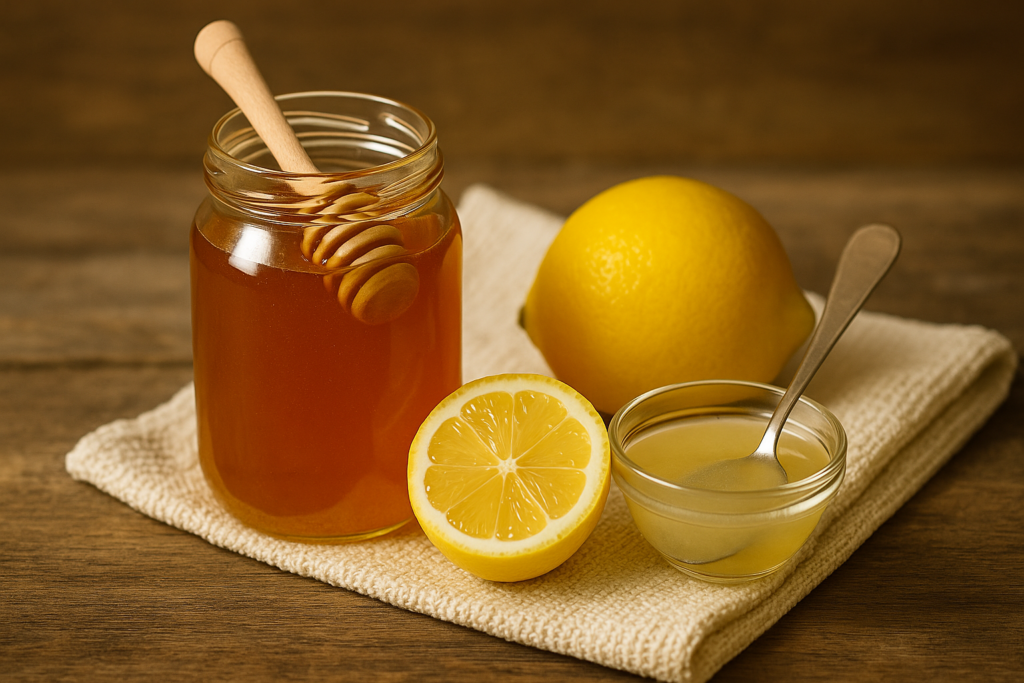
Long before over-the-counter cough syrups filled supermarket aisles, moms reached for two pantry staples that dated back centuries: honey and lemon. This duo was the preferred ’50s remedy for soothing coughs, especially those caused by colds or seasonal allergies. Lemon juice offered a dose of vitamin C and astringent properties that helped cut through mucus, while honey provided a thick, sweet coating that calmed throat irritation. It wasn’t just a comfort drink it was often given on a teaspoon like medicine or mixed with warm water and sipped slowly. Honey’s viscosity helped trap irritants and quiet the reflex to cough, giving the throat time to heal. This remedy dates back to ancient Greece and was particularly common during cold seasons when doctors were scarce and pharmacies closed early. In the ’50s, many households relied on local or clover honey, believing darker honeys worked better for deep, chesty coughs.
Science later confirmed what mothers already knew. A 2007 study published in Archives of Pediatrics & Adolescent Medicine found that honey was more effective than dextromethorphan (the active ingredient in many commercial cough syrups) at reducing nighttime coughing in children. The World Health Organization also recognizes honey as a legitimate demulcent a substance that relieves irritation in mucous membranes particularly helpful in upper respiratory tract infections. Unlike cough suppressants, which can sometimes delay recovery by halting productive coughing, honey soothes without interfering with the healing process. Lemon juice, while not a miracle in itself, helps cut through phlegm and adds antioxidants that support the immune system. Doctors today still recommend this combination for patients over the age of one (honey is unsafe for infants due to the risk of botulism). It’s proof that some of the most effective remedies are also the most natural and the most delicious. Source: Mayo Clinic
5. Oatmeal Baths for Itchy Skin

In the 1950s, when kids came down with chickenpox, poison ivy, or mysterious rashes from who-knows-where, the answer was almost always the same: an oatmeal bath. Moms would grind rolled oats into a powder or tie them in a washcloth and swirl them through a warm tub until the water turned milky. The bath wasn’t just for comfort it worked. Oatmeal contains compounds called avenanthramides and beta-glucans, which help reduce inflammation, relieve itching, and strengthen the skin’s barrier. These baths were a staple in homes without access to steroid creams or antihistamines, and they were even recommended in parenting guides and pediatrician pamphlets of the time. The ritual became especially popular during summer months, when bug bites and sunburns sent kids scratching and squirming. Families living in rural areas often swore by home-ground oats, claiming they worked better than store-bought brands due to freshness and texture.
Modern dermatology supports the wisdom of this home remedy. Colloidal oatmeal finely ground oats processed to retain active skin-soothing components is still prescribed today for eczema, psoriasis, chickenpox, and general itching. The FDA officially classified colloidal oatmeal as a skin protectant in 2003, and it’s now found in dozens of creams, lotions, and bath products recommended by dermatologists. A 2015 review in the Journal of Drugs in Dermatology confirmed that oatmeal baths improve skin hydration, reduce inflammation, and form a protective barrier on damaged or sensitive skin. Unlike harsher treatments, oatmeal is gentle enough for babies and those with severely irritated skin, making it ideal for sensitive populations. The baths are typically safe, inexpensive, and easy to prepare at home by blending plain oats into a fine powder. Seventy years later, the same fix your grandmother used is now dermatologist-approved and still soaking in tubs across the country. Source: Journal of Drugs in Dermatology (JDD)
6. Castor Oil for Constipation

If there was one remedy every ’50s kid dreaded, it was castor oil. Kept in the kitchen cabinet or bathroom drawer, this thick, bitter-tasting oil was the universal solution for sluggish bowels, especially in children. Derived from the seeds of the castor plant (Ricinus communis), castor oil contains ricinoleic acid, a compound that stimulates the intestines by triggering muscle contractions in the walls of the bowel. A single tablespoon could produce results within two to six hours, making it a go-to remedy for “cleaning out the system” before road trips, school events, or post-holiday sluggishness. Mothers often mixed it with orange juice to mask the taste, though few children were fooled. It was even used in maternity wards to induce labor by stimulating uterine contractions, though this use has since fallen out of favor. Still, its dramatic and near-guaranteed effects made it a staple in mid-century medicine cabinets.
Today, castor oil is still recognized as an effective stimulant laxative and is listed as such by the U.S. Food and Drug Administration. A 2010 study in the Journal of Complementary and Integrative Medicine confirmed its effectiveness in relieving constipation in elderly patients, particularly when standard fiber-based laxatives failed. However, it’s now used more cautiously due to potential side effects like cramping, dehydration, or dependency when overused. Unlike bulk-forming laxatives, castor oil works by chemically irritating the intestinal lining, which can be too intense for some users. It’s also contraindicated during pregnancy due to its uterine-stimulating properties. That said, castor oil has found a second life in modern wellness circles, often used topically in “castor oil packs” for inflammation and pain relief. While it’s no longer the first remedy handed to children, it remains one of the oldest and most chemically active digestive treatments in both historical and modern medicine. Source: Cleveland Clinic
7. Applying Butter to Burns (and Why That Changed)

In 1950s kitchens, if someone accidentally grabbed a hot skillet or touched a stove coil, the first instinct was to reach for the butter dish. Butter was considered a miracle fix; it was cooling, accessible, and thick enough to form a protective layer over the skin. Mothers believed it “sealed the burn,” preventing air exposure and calming the sting. It was often paired with ice cubes or held in place with gauze or a tea towel. Some variations included mixing butter with flour or baking soda to make a paste, especially for grease splatters or oven rack burns. This practice wasn’t just anecdotal, it was passed along in home economics classes, newspaper clippings, and even Red Cross first-aid manuals prior to modern medical updates. The greasy fix offered a kind of comfort and consistency during a time when doctors weren’t always nearby and burn creams were still relatively new.
But despite its popularity, butter has since been debunked as a burn treatment. According to the American Burn Association, applying butter can trap heat inside the skin, increasing tissue damage and the risk of infection. Instead, the most effective treatment is to immediately run cool (not ice-cold) water over the burn for 10 to 20 minutes to reduce skin temperature and inflammation. Once the area is clean and dry, sterile gauze or a non-stick bandage is best. That said, the reason butter felt helpful was because its coolness briefly numbed nerve endings, and some homemade butter included salt, which may have had a mild antibacterial effect. Today, topical treatments like silver sulfadiazine or aloe vera gel are far superior in reducing healing time and preventing complications. Butter may have been a comfort-based fix, but science now shows it likely did more harm than good when used on open or deep burns. Source: America Burn Association
8. Prunes (or Prune Juice) for Digestion

If you complained about “not going” in the 1950s, your mom didn’t call a pediatrician, she handed you a small bowl of stewed prunes or a glass of prune juice and told you to sit tight. Prunes, which are dried plums, were a staple in mid-century kitchens and lunchboxes, often underestimated for their potent laxative effects. Moms soaked them overnight or simmered them with cinnamon to make them more palatable, especially for children. The reason they worked so well lies in their high content of sorbitol, a naturally occurring sugar alcohol with osmotic properties, meaning it pulls water into the colon and stimulates bowel movement. Prunes also contain soluble and insoluble fiber, helping to bulk and soften stool while promoting the growth of beneficial gut bacteria. By the ’50s, they were so well-known as digestive helpers that prune juice was marketed directly to parents as a safer, natural alternative to over-the-counter laxatives.
Modern nutrition research continues to uphold prunes as one of the most effective natural remedies for constipation sometimes outperforming fiber supplements. A 2011 study published in Alimentary Pharmacology & Therapeutics found that adults who ate 100 grams of prunes daily (about 10 to 12 pieces) experienced significantly more bowel movements than those who took psyllium fiber. Prunes are also rich in potassium, vitamin K, and antioxidants, making them beneficial for bone health and inflammation, particularly in postmenopausal women. Even NASA includes prunes in astronaut diets to help counteract bone density loss in space. While they fell out of fashion in favor of flashy fiber drinks and pills, prunes are experiencing a quiet comeback often rebranded as “dried plums” to appeal to younger consumers. Still, to anyone raised in a 1950s household, they’ll always be prunes: the small, wrinkled miracle your mom swore by. Source: Medical News Today
9. Mustard Plaster for Chest Congestion
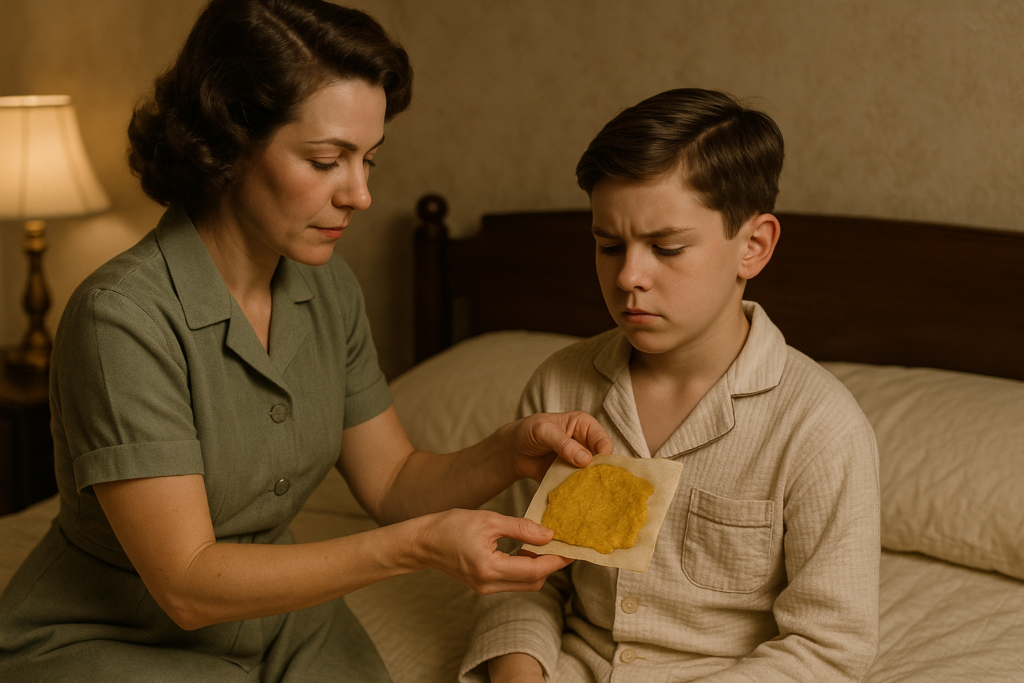
In the 1950s, when a cough turned deep and rattly, many mothers skipped the pharmacy and turned to something pungent, messy, and oddly effective: the mustard plaster. This old-school remedy involved mixing dry mustard powder with flour and a little water or vinegar to form a paste, then spreading it between layers of cloth and placing it on the chest or back. The idea was to stimulate circulation, generate warmth, and draw out mucus through the skin. The heat created by mustard’s active compound, allyl isothiocyanate, triggered a mild inflammatory response, increasing blood flow and loosening phlegm in the lungs. This method dated back centuries and was used to treat bronchitis, pneumonia, and severe colds before antibiotics were widely available. In the postwar years, Vicks often replaced mustard for milder cases, but for hard-core chest colds, the plaster remained a fixture especially in homes where doctors weren’t affordable or accessible.
Today, mustard plasters are less common, but the principle behind them still informs modern medicine. The same warming effect is now used in mentholated rubs, capsaicin creams, and other counter-irritants that stimulate the skin to ease deeper discomfort. A 2010 study in the Journal of Alternative and Complementary Medicine noted that topical mustard applications increased blood flow and could reduce muscle tension and cough symptoms, though they must be used cautiously to avoid skin burns. While not scientifically proven to extract mucus through the skin, as once believed, the plasters’ effectiveness may come from reflexive nervous system responses triggered by the warming sensation. Some holistic practitioners and herbalists still use mustard wraps today, especially in Europe. Modern versions use milder ratios or even mustard oil infused into compresses. As with many ’50s remedies, the trick wasn’t in a pharmaceutical label, but in heat, circulation, and the body’s natural healing instincts, wrapped in cloth and a mother’s care. Source: National Library of Medicine
10. Apple Cider Vinegar for Digestive Troubles
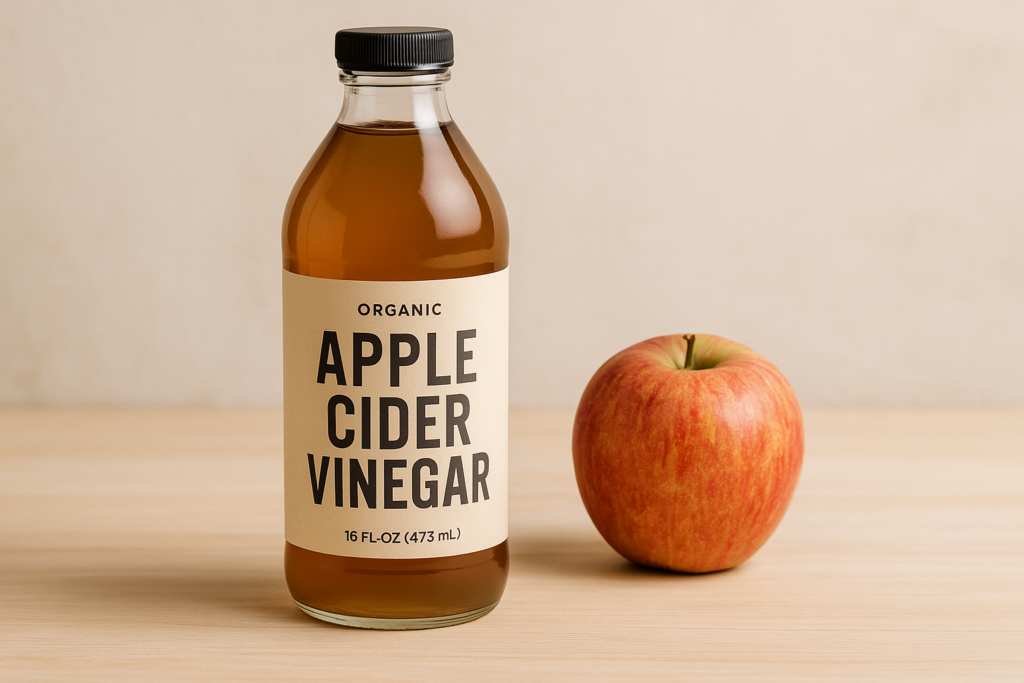
In many ’50s households, apple cider vinegar (ACV) was more than a pantry item it was a trusted tonic for everything from indigestion to fatigue. Moms would dilute a tablespoon or two in a glass of warm water and serve it before meals to “settle the stomach” or after heavy dinners to reduce bloating. Some added honey for taste, turning it into what they called a “health cocktail.” The thinking was simple: vinegar balanced the system, improved digestion, and acted as a mild antiseptic internally. Though acidic in nature, ACV was believed to help regulate stomach acid, particularly for those experiencing indigestion from rich foods like meatloaf, gravies, or dairy-heavy casseroles common in 1950s fare. Many families swore by it as a daily preventative or cure-all, with anecdotal claims passed down far more often than medical explanation.
Today, while some claims about ACV remain unproven or overstated, its role in aiding digestion is gaining clinical interest. A 2007 study published in BMC Gastroenterology showed that vinegar delayed gastric emptying in healthy individuals, which may reduce post-meal blood sugar spikes and extend satiety. For those with low stomach acid (a common but underdiagnosed cause of reflux), small amounts of ACV can help re-acidify the stomach environment, aiding in the breakdown of proteins and absorption of nutrients. ACV has also shown antimicrobial properties and modest benefits in improving gut flora balance. However, it’s not a magic bullet: drinking it undiluted can damage tooth enamel and irritate the esophagus. For occasional digestive upset, though, it remains a natural, affordable remedy still used by many holistic practitioners and nutritionists today just as it was by mothers stirring cloudy vinegar into glasses long before kombucha became trendy. Source: BMC Gastroenterology
11. Clove Oil for Toothaches

In a 1950s kitchen, if someone was wincing from a sudden toothache, there was no rush to the dentist just a quick reach into the spice rack. Clove oil, or even a single whole clove pressed gently against the gum, was a time-honored fix that had been used for centuries to numb dental pain. The secret ingredient is eugenol, a natural anesthetic and antiseptic compound found in cloves. When applied directly to the affected area, eugenol temporarily deadens nerve endings and reduces inflammation, offering rapid, localized relief. Moms in the ’50s often soaked a cotton ball in clove oil and placed it on a painful molar, or tucked a clove into the cheek to slowly release its numbing effect. This method was especially common in rural areas or during weekends when dental offices were closed. It was also seen as a more natural and affordable option than over-the-counter analgesics, which were limited at the time.
Clove oil remains a staple in many emergency dental kits today, and modern dentistry continues to validate its power. Eugenol is still used in professional dental procedures, especially in temporary and cavity dressings. A 2006 study published in Phytotherapy Research confirmed that clove oil’s eugenol content significantly reduced tooth pain and had antimicrobial properties that could inhibit the growth of oral bacteria. It’s especially helpful for dry socket pain after tooth extractions and is commonly included in over-the-counter oral pain relief gels. Though it should never be swallowed in large amounts or applied directly in pure form to broken skin (it can burn soft tissues), when used carefully, clove oil is considered safe and effective. Many holistic dentists continue to recommend it as a stopgap for tooth pain, proving that this humble spice rack remedy still holds up under scrutiny. Source: Medical News Today
12. Chicken Soup for Colds and Flu
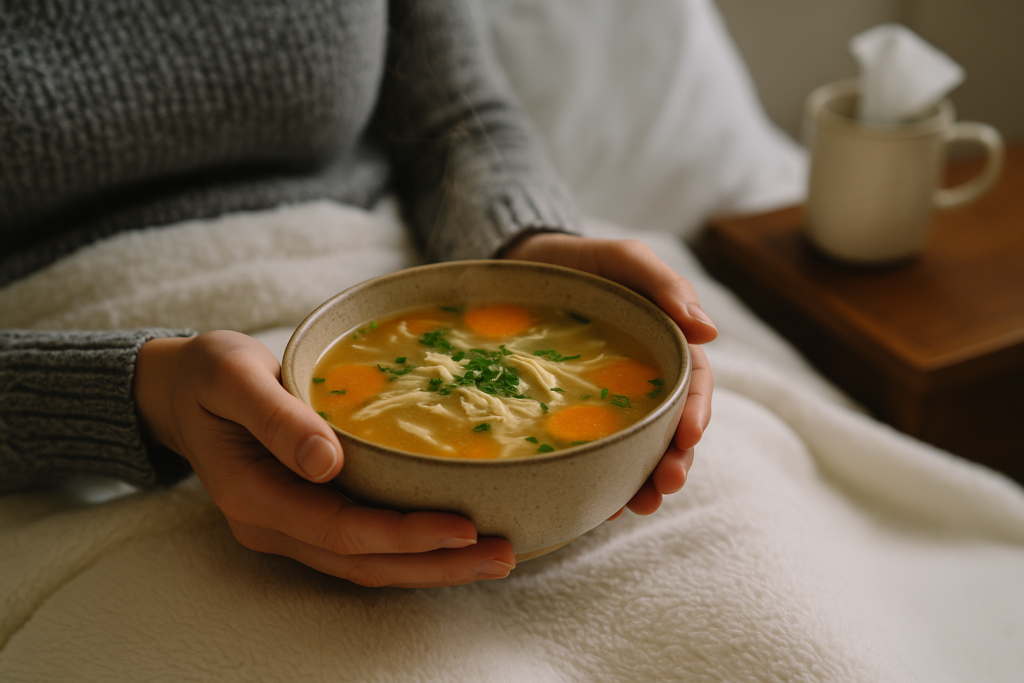
In the 1950s, if you were coughing, feverish, or just plain wiped out, there was one prescription you could count on from any mom: chicken soup. Not from a can, but homemade from scratch, with bone-in chicken, vegetables, and simmered for hours on the stove. Known affectionately as “Jewish penicillin” in many households, chicken soup was more than comfort food. Moms believed it helped clear congestion, restored strength, and coaxed even the sickest child to sip something nourishing. The warmth helped soothe sore throats, while the steam eased nasal passages. The salt, fat, and gelatin-rich broth also delivered calories and hydration when appetite was low. Chicken soup became a cornerstone of postwar home recovery, especially when doctors were costly or house calls were rare. Every culture had its variation, from matzo ball soup to arroz caldo each one lovingly served as medicine you didn’t mind eating.
Modern studies show that chicken soup’s healing powers aren’t just in your head. A 2000 study from the Chest Journal found that chicken soup has mild anti-inflammatory effects, helping to slow the movement of neutrophils, which are immune system cells that cause congestion. The combination of hot liquid, sodium, and nutrients creates a synergistic effect: thinning mucus, rehydrating the body, and stimulating the tiny hair-like cilia in the nose that filter pathogens. The amino acid cysteine, released from chicken during cooking, chemically resembles acetylcysteine, a drug used to treat respiratory infections. While chicken soup doesn’t cure viral illnesses, it may ease symptoms better than many commercial cold remedies. Doctors today still recommend it as part of supportive care for upper respiratory infections, particularly in children and older adults. Your mom’s soup pot wasn’t just comfort, it was an accidental chemistry lab with real clinical merit. Source: Chest Journal
13. Epsom Salt Soaks for Aches and Pains

In the 1950s, after a long day of housework, yardwork, or hauling groceries up the stoop, many moms swore by a hot bath with a generous scoop of Epsom salts. Known chemically as magnesium sulfate, Epsom salt was a household staple kept in paper cartons under the bathroom sink or tucked in linen closets. Moms used it for everything from sore feet and aching backs to mild sprains or tension headaches. The warm water helped muscles relax, while the dissolved salts were believed to draw out inflammation and reduce swelling. It was also common to soak infected fingers, ingrown toenails, or bruises in a small basin with Epsom salt and water. Some mothers even used it as a laxative or mixed it into poultices for bug bites and styes. Affordable, easy to store, and multifunctional, Epsom salt was a quiet workhorse in the medicine cabinets of mid-century America.
Modern science supports some of these uses particularly the magnesium component. When dissolved in warm water, Epsom salt may be absorbed through the skin in small amounts, delivering magnesium to the muscles and potentially helping with cramps or general soreness. A 2017 review in Nutrients journal found that transdermal magnesium therapy can moderately improve magnesium levels, especially in those who are deficient, though results vary by individual. Magnesium plays a crucial role in over 300 biochemical reactions in the body, including those involved in muscle contraction and nerve signaling. Epsom salt’s sulfate component may also assist in detoxification and skin health. While it isn’t a miracle cure, Epsom salt remains a low-risk, cost-effective way to ease aches, reduce stress, and soften skin. It’s still used in sports recovery, physical therapy, and even gardening and its presence in bathrooms today is just as common as it was in your grandmother’s day. Source: Washington State University
14. Warm Milk Before Bed for Insomnia
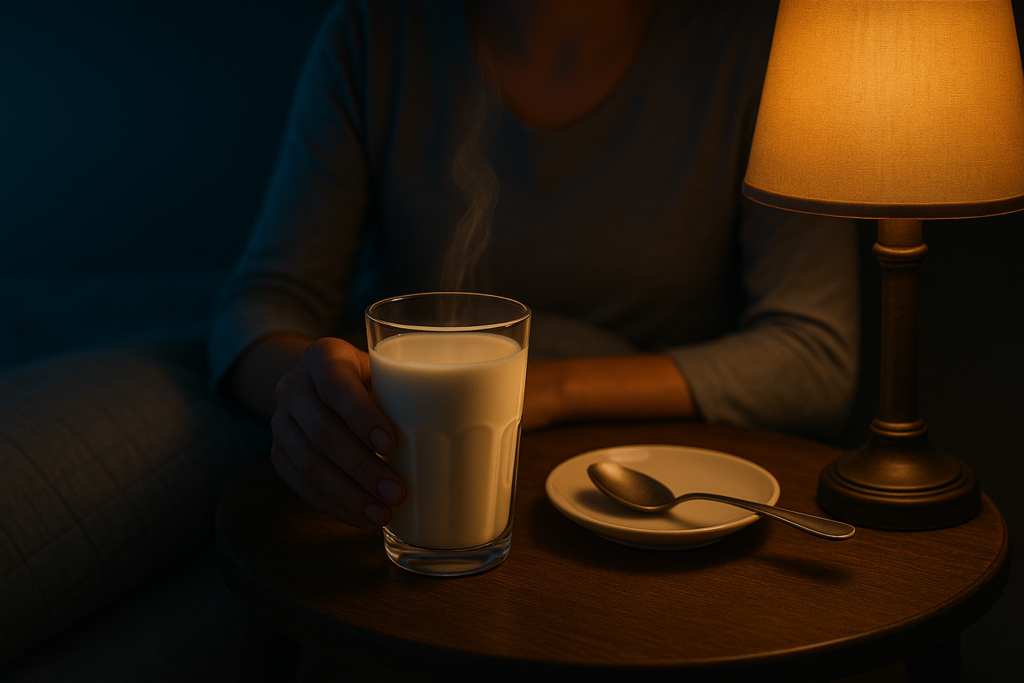
In mid-century homes, bedtime wasn’t just about turning off the lights, it was a ritual. And at the center of that ritual was a warm mug of milk, often served with a touch of honey or a sprinkle of nutmeg. Moms in the 1950s believed this simple drink helped children, and sometimes themselves, fall asleep faster and stay asleep longer. The warmth provided physical comfort and signaled winding down, while the milk itself was thought to “make you sleepy.” It was often paired with a cozy blanket and a storybook, reinforcing a nightly sense of security. At a time when over-the-counter sleep aids were limited and rarely used for children, warm milk was the go-to solution for restlessness, stress, and even nightmares. It was a natural part of family rhythms, handed down through generations and observed across many cultures, from Scandinavian households to rural American farms.
Modern science has since explored whether milk’s sleep-inducing reputation holds up, and in many ways, it does. Milk contains tryptophan, an amino acid that serves as a precursor to serotonin and melatonin, both crucial hormones in the regulation of sleep cycles. While the amount of tryptophan in a single glass isn’t enough to cause drowsiness on its own, the presence of carbohydrates (like honey) can boost its absorption, making the combo more effective. A 2018 study published in Nutrients confirmed that milk proteins, particularly alpha-lactalbumin, can improve sleep quality, especially in those with high stress or sleep disorders. Warm liquids may also stimulate parasympathetic nervous activity, helping the body shift into a state of rest. Today, dietitians and sleep researchers still recommend warm milk as part of a calming bedtime routine, especially for older adults and children. It’s a gentle, time-honored bridge between busy days and restful nights. Source: Sleep Foundation
15. Onion Poultices for Coughs and Congestion
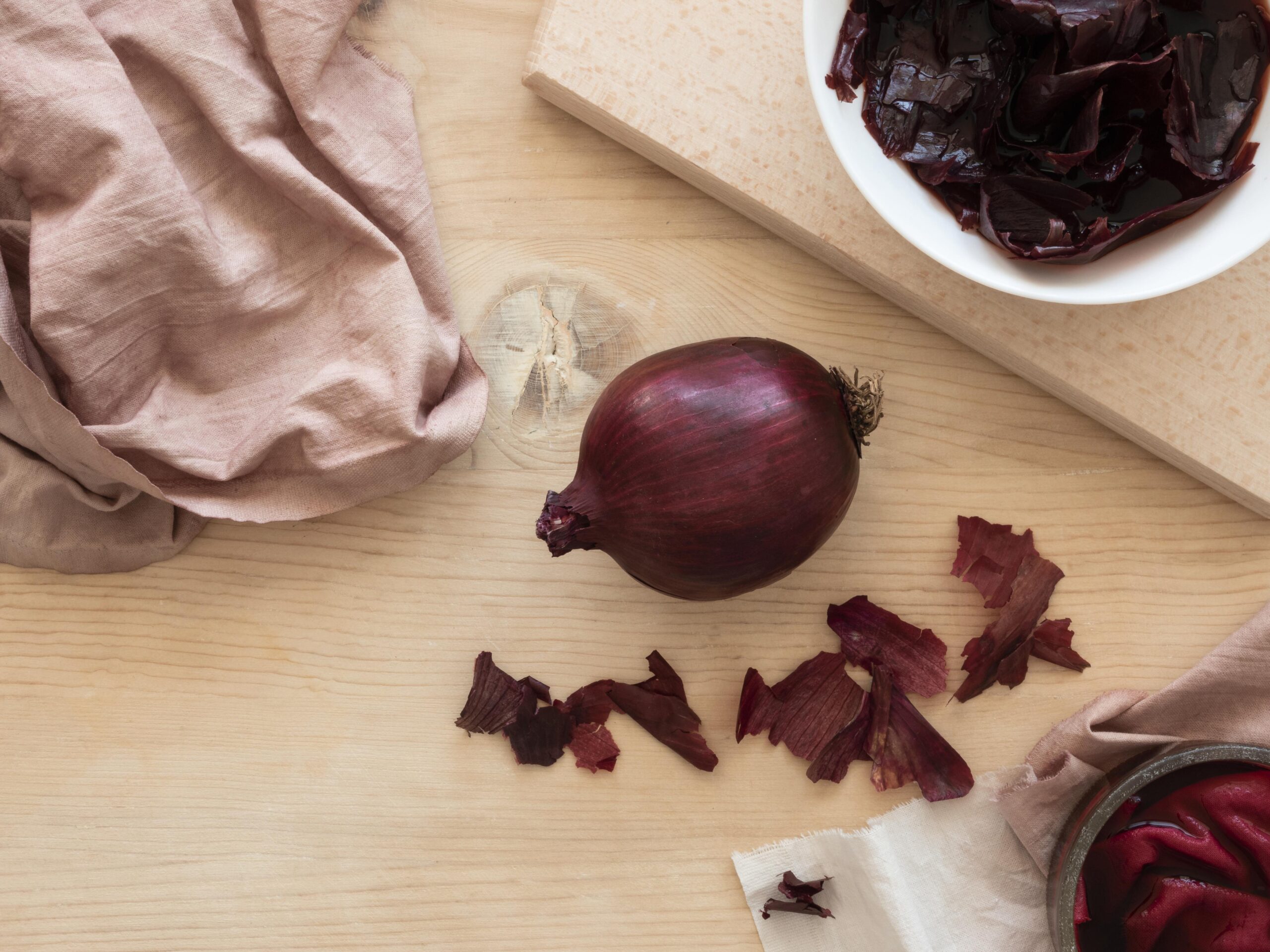
If a 1950s child had a deep, lingering cough or chest cold, chances were good that a mom or grandmother would slice an onion and turn it into a poultice. The method was surprisingly simple: chopped or lightly sautéed onions were wrapped in a warm cloth and placed on the chest, back, or even soles of the feet. Sometimes they were mixed with mustard, garlic, or lard to increase the effect. The theory was that the vapors and natural compounds released by onions, especially sulfur-containing ones like allicin, could break up phlegm, open nasal passages, and stimulate circulation. Families who couldn’t afford doctors or trusted folk medicine over pharmaceuticals swore by it. In some cases, raw onion was placed beside the bed or rubbed directly on the soles to “pull out the sickness.” It wasn’t pretty, and it didn’t smell great, but for many households, it was the first and most dependable line of defense.
While it sounds like old wives’ lore, modern research has given this pungent practice some credibility. Onions do contain sulfur compounds that have known antimicrobial and anti-inflammatory properties. A 2012 study in Evidence-Based Complementary and Alternative Medicine noted that allicin (also found in garlic) exhibits strong antibacterial activity against respiratory pathogens. The heat from the poultice increases local blood flow, which may aid in immune response and loosen mucus, much like modern chest rubs or warm compresses. While placing onions on the feet has little scientific basis, inhaling vaporized sulfur compounds may offer some respiratory relief—particularly in steam applications. Today, natural health circles still use onion poultices for bronchitis and stubborn chest congestion, proving that while it may not replace medical care, it’s far more than a superstitious cure. Your grandmother’s kitchen remedy wasn’t just quirky, it had chemistry behind it. Source: Dr. Green Mom
The Wisdom We Almost Forgot
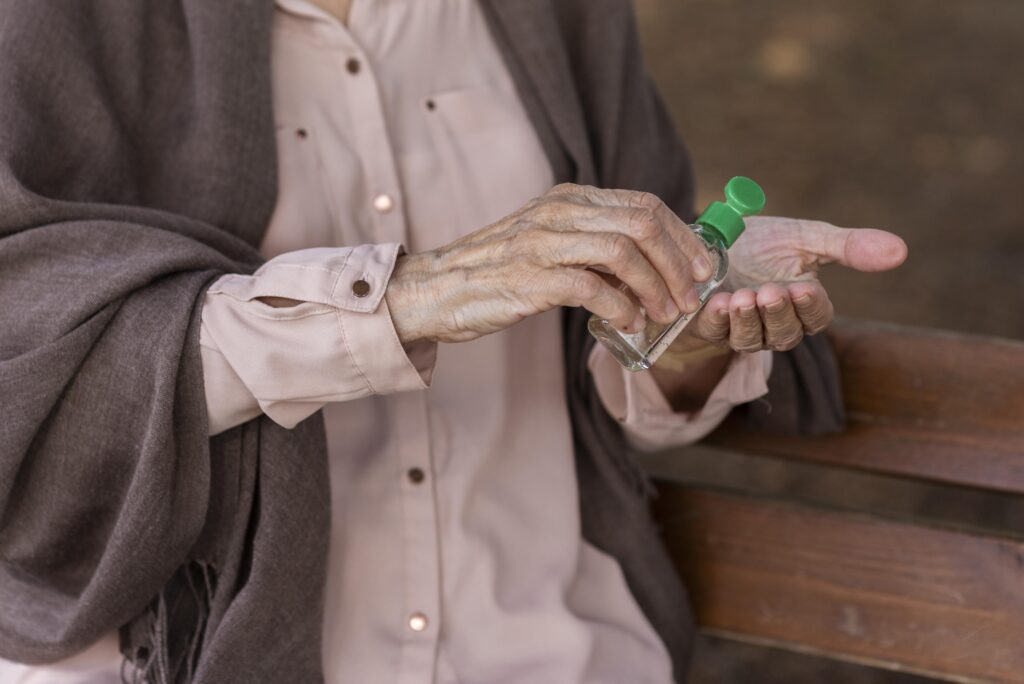
They didn’t have Google, urgent care, or medicine by subscription. They had root cellars, spice racks, and a kind of practical magic passed from hand to hand. These 15 home remedies weren’t just makeshift solutions; they were acts of care, born from necessity and refined by observation. And while modern pharmaceuticals have replaced some, many still hold their own in clinical studies, proving that Mom, and often Grandma, knew what she was doing all along.
Today, science may wear a lab coat, but sometimes its findings echo the scent of Vicks on your chest, the sting of salt water on a sore throat, or the bitter tang of castor oil on a spoon. Whether you use these remedies as your first line of defense or as comforting complements to modern care, they remind you that the past isn’t outdated, it’s often just waiting to be rediscovered.


